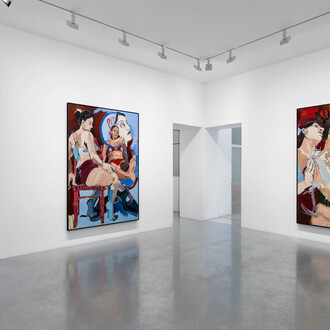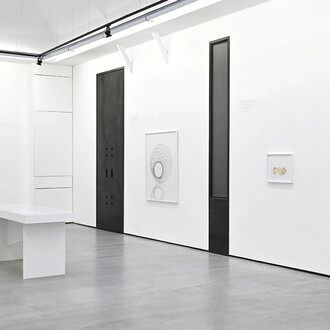A few years ago, Emily Mae Smith selected an unexpected yet inexhaustible muse: a simple straw broom, dually anthropomorphic and gendered (the artist applies the pronoun “she”).
In the exhibition Harvesters, we find “her” without the round glasses the artist frequently accessorized her in, and is seen either disguised as a scholar-candle and burning down while reading a book of spells (The Alchemist), resting languidly in a wheat field (Harvester), feasting (or rather attempting to) in a Flemish interior (The Wooden Spoon), standing in a damp cave with a paintbrush in hand (The Grotto), carrying a message in the street (The Messenger) or hidden behind a wall of ginkgo biloba leaves (Blush). She is proud or overwhelmed, weeping or focused on a task—even crucified.
This omnipresent figure shouldn’t be viewed as a character switching between costumes or settings, returning from one season to the next to parade before our eyes. Emily Mae Smith’s paintings work on a symbolic, rather than narrative level. Her images evoke mythology, still life, and even those lovely allegories so common among Belle Epoque masters. Unlike Baldessari’s mocking message circa 1968 (“no ideas have entered this work” proclaimed of one his paintings at the time), the images here are loaded with ideas, values and symbols.
Let’s try to sweep (!) its spectrum. The broom is an instrument for cleaning. It is also a substitute for the female body: passive, denuded and almost constantly objectified within the Western art tradition (recall John Berger in Ways of Seeing: “Men act and women appear. Men look at women. Women watch themselves being looked at”). It connotes the power of labor, the domestic domain (re: women) and domesticity. It’s a pop culture gearshift, to draw from Disney’s The Sorcerer’s Apprentice, which evokes those female figures we have recently begun to celebrate again: witches. In the exhibition, the broom also carries a set of metaphors regarding its origins, with wheat fields as the source of its bundled straw bristles.
A perfect analogue to the paintbrush, the broom is, in fact, a gleaner gathering crumbs: gleaning those morsels still available from the mostly male-dominated history of art, in an attempt to make something new: a cartoonish figure of late postmodernism. Flat Pop painting, Flemish painting (including an emphatic homage to Brueghel the Elder and one to the genre of collector’s cabinet painting), plus the Symbolist tradition, all make forays into the exhibition. The Grotto, for example, is a remake of La Vérité by Jules-Joseph Lefebvre (1870), itself a remake of La Source by Ingres (1856). “Painters always paint in reference to other painters. In recent years, as my practice evolved, I began to wonder if the subject of my work was not just the world of painting itself,” the artist explained, who here methodically reverses the symbolic order by painting with Marxist as well as feminist accents. Humor replaces the Great Seriousness. Rest and retirement figure in rather than labor, and the relationship between work/power is rendered visible. The patriarchal order of the gaze is upended (“she gazes back,” notes the artist about The Alchemist’s eye).
A simple tool for the dirty work of cleaning, erected amidst a cavern of irises, becomes a glorious feminized allegory for creation. By the same logic, the artist reframes the rat in a positive light. This intrusive and harmful pest, an insult commonly thrown at women, occupies a prominent place in two of the most attractive paintings of the exhibition—which could just as easily have been titled “the contemporary condition of the female painter facing the aggressively masculine history of art.” Note that the great mastery of painting techniques joins avid erudition, with Tidal Animal Vegetable constituting a sort of archive of all those employed for the production of the show (grisaille, clear line).
That a simple broom can synthesize so many pictorial and political questions is quite magical. We start wondering about artists who might have invested an unexpected motif with as much determination. There’s the egg in Kippenberger’s work (“In painting you have to be on the lookout: what windfall is still left for you to paint. Justice hasn’t been done to the egg, justice hasn’t been done to the fried egg,” the German artist told Daniel Bauman when questioned about his strange choice of motif in 1996). The bowtie by Belgian painter René Daniëls is also worth citing, again perfectly synthesizing in its ability to bring social and institutional criticism together, to evoke art’s high-society frivolities as well as a thousand subtleties of configuring exhibition spaces.
However, a proper history of incongruity in art has yet to be written. Illustrious artists and strangers coming straight out of the burial ground— where “lazy condemnations” got them thrown in, in the first place—would encounter one another, and the strangeness of the metaphor would reign.
Gaetano Pesce would rub shoulders with Hieronymus Bosch, Rosa Bonheur and Meret Oppenheim, in a setting inspired by Frank Gehry’s Chiat/Day Building and Magritte’s Vache period. Medieval and Symbolist fantasies would happily flow. And Emily Mae Smith’s comic, dreamlike paintings would have their rightful place there. In the meantime, traditional history—which has always had a bit of trouble with anomalies—continues to unfurl and to consign everything that breaches decorum into oblivion.
(Jill Gasparina)
















